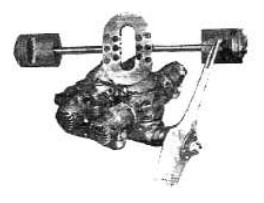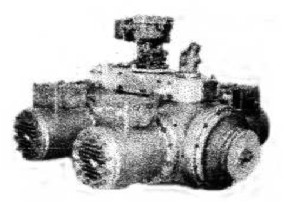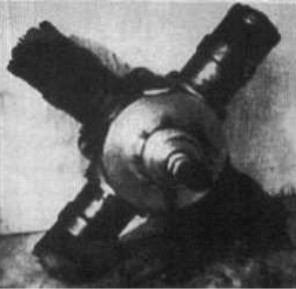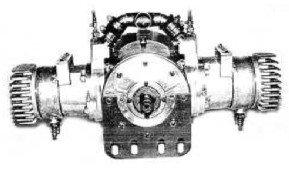Updated: 30-Jan-2020
Russel Bourke made an experimental 2-stroke engine built with modules that consist of two opposed cylinders and can be coupled to make engines with 2, 4, 6 ... cylinders.

"First Bourke"
-Its main feature is the connecting rod system, which is rigid. It connects the pistons of the aligned opposite cylinders, (like the Berthaud et Prini (see)) working as a shuttle.
-Colloquially referred to as "Scotch Yoke".

"Bourke module"

"Four-cylinder Bourke engine"
-Now we present a Bourke in an animated image that we copied from bourke-engine.com.
-It is the 4-cylinder, 4-stroke engine with a displacement of 400 cu.in. It has no connecting rods: the two pistons are connected by a rod-yoke with a central eyelet allowing the rotation and sliding of the crankshaft.

"Esquema del Bourke en vista frontal"
-This engine gives 200 hp at 2000 rpm with a high torque. It is a liquid-cooled, 2-stroke engine.
-Its builder proclaims that it has only 3 moving parts.
From appendix 6: Rusell Bourke made his first engine prototype by 1932.
-His engines are characterized by having opposed cylinders with rigid pistons and rod-yokes, acting like shuttles.
-In the center it can be considered "connecting rod" as it has an elongated hole where the crankshaft rotates. This mechanism is also known as the Scotch Yoke.
-In Popsci, we have located a four-cylinder, radial Bourke engine. It has opposed cylinders in pairs, of course.

“El Bourke radial” (PiP)
-In the 1930's, Russell Bourke designed an engine without connecting rods: it had a rod-yoke that connected the two pistons of the opposed cylinders.

"Bourke's characteristic view"
Engines of BOURKE
Model: 2 cils. boxer
Model: 4 cils. boxer

"Four-cylinder Bourke"
Model: 4 cils. en “X”

"Bourke radial" (PeT)


